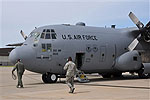USAFE fighter squadrons affected by sequestration
 RAMSTEIN AIR BASE, Germany (AFNS) -- Nearly half of the fighter squadrons in U.S. Air Forces in Europe - Air Forces Africa halted flying operations three weeks ago.
RAMSTEIN AIR BASE, Germany (AFNS) -- Nearly half of the fighter squadrons in U.S. Air Forces in Europe - Air Forces Africa halted flying operations three weeks ago.
The action was a result of the reduction of flying hours Air Force-wide -- one impact of the current sequestration-related budget challenges affecting the Defense Department. When factoring in ongoing and anticipated deployments, there is limited ability to respond to operational requirements across two combatant commands.
The Air Force flying hour program shrinks or grows based on the amount of money available. Each year Air Force leaders make decisions regarding how much flying their units can afford. In the past, flying hours were assigned to wings with the goal of keeping their aircrews trained and at the highest readiness level. This year, due to the reductions forced by sequestration, Air Force officials were unable to program enough money to keep all fighter squadrons trained.
Air Combat Command officials assigned or reduced flying hours to fighter squadrons throughout the Air Force commensurate with their expected fiscal 2013 tasks and deployments. To balance fiscal restraints with worldwide requirements, the decision was made to reduce the flying hours for two and a half USAFE fighter squadrons to zero.
Aircrews assigned to the other three and a half fighter squadrons will remain ready, trained and able to fight, said Lt. Gen. Tom Jones, the USAFE vice commander.
"Units preparing to deploy in support of major ongoing operations will remain fully mission capable," Jones said. "The risk we face is that combat airpower may not be ready to respond to unforeseen contingencies and crises when called upon. With these fighter squadrons stood down, we just do not have a deep bench to respond immediately.
"We will make every effort to provide ready, responsive forces to meet current and anticipated requirements of our combatant commanders," he said. "Despite these fiscal cutbacks, our planners continue to evaluate scenarios and options to best use the assets that remain ready as effective response options."
Over time, the erosion of proficiency and currency of the fighter pilots, the weapons system operators, and the maintainers in the units that stood down is an additional concern for USAFE. Regaining that proficiency will be a significant effort once flying resumes.
The stand down will also reduce Air Force participation in NATO missions.
"We are closely coordinating with European Command, Africa Command, and in some cases Central Command as we implement flying hour cuts to determine which activities will be curtailed, delayed or cancelled," Jones said. "We also work with the air chiefs of affected countries to provide as much advance notice as possible to both the air chiefs and our counterparts in the U.S. State Department as these situations arise."
Meanwhile, the USAFE staff is reevaluating how to recover and retrain after the stand down ends.
"Currently, flying hour cuts will only ground our aircraft through Sept. 30, 2013," said Col. Jeff Weed, a deputy director of operations for USAFE's. "We will have to reassess our program within the parameters of the fiscal 2014 budget and projected fiscal year flying hours. Next year, most of the first quarter will be spent getting these grounded squadrons back to full readiness. So even if flying hours are fully funded in fiscal 2014, which is doubtful, USAFE fighter squadrons will be dealing with the effects of sequestration for some time to come."
Airlift and air refueling squadrons have also been affected, but to a lesser extent.
"Our C-130 Hercules squadron and our KC-135 squadron are both still ready and available for tasking, but they are not flying at a rate that will ensure that all aircrew are trained in 100 percent of the mission," said Col. Mark Hering, also a deputy director of operations for USAFE. "The unit commanders are closely evaluating the training levels of their Airmen to ensure that they are capable of executing the tasks assigned."
Hering added that the staff is working to understand and minimize the secondary effects of this reduced level of flying including the parachute jump requirements and air refueling requirements of USAFE, other services and other nations.
"Each day the funding and flying hour situation changes and this is a very difficult balancing act," he said.